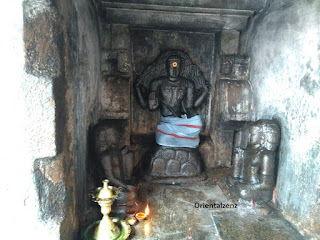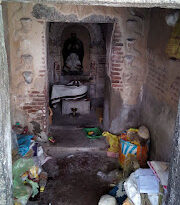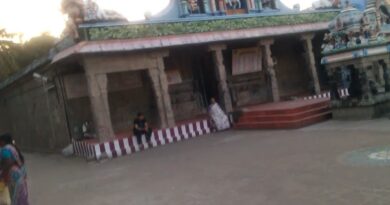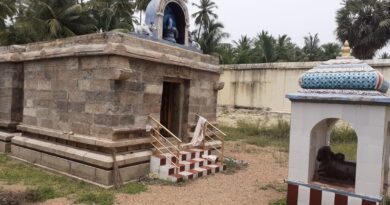Thirunedungalam – Shri Nedungalanathar Shiva Temple
Thirunedungalam – Shri Nedungalanathar Shiva Temple
We all must have read many of our “Stotra granthas” i.e Soundarya Lahari, Shivananda Lahari and Lalitha Sahasranamam etc. However, when we go to any temple, Would we anytime interpret some slokas or names of “Sahasranamas” with the presiding deities of the particular temple and get mesmerized. The answer may be yes/no depending upon individual person. Now, let us go to one temple which is situated amid of paddy fields in small village but being a testimony to the various names of Lalitha Sahasranamam.
The temple is “Thirunedungalam Shri Nedungalanathar Temple”.

Location:
This temple is in Trichy district, Tamilnadu and 21KM from Trichy.
There is place called Thuvakkudi in Trichy to Thanjavur route 17 KM from Trichy and There is separate route on left side from Thuvakkudi and Thirunedungalam is being at 4th KM in that route.
On the other route, it is 42 KM away from Thanjavur.
There are buses available from Trichy Chathram bus station towards Maangavanam and these buses are used to go through Thirunedungalam. The best option is to arrange private cabs from Trichy and covers these area and devotees can have dharshan of another temple nearby i.e Thiruverumbur,
Significance of the Temple:
- This temple is one among the 275 temples mentioned in Tamil devotional literature called Tevaram.
- An ardent devotee and Tamil Sage Thirugnanasambandar came to this temple on 7th century and praised the deity in 10 beautiful verses in Tamil and the same is being currently called as “Idar Kalaiyum Pathigam in Tamil”. It means, the 10 verses are capable of eradicating all difficulties of an individual who recites it.
- These ten verses of Thirugnanasambandar predominantly speaks about various incidents from Puranas of Mahadeva and the devotee the one who always remembers the same will eventually overcome all the obstacles due to the blessings of Thirunedungalam Shri Nedungalanathar
- The great sage among all sages Agasthiyar came to this temple and established a well and worshipped Nedungalanathar and The respective well is still there in the temple and being called in the name of “Agasthiya teertham”
- Since the mahadeva blessed the Chozha king with his wedding dharshan, Shri Nedungalanathar is also being called as “Nithya Sundareshwarar”.
- There are around 50 inscriptions in this temple complex from Pallava dynasty to, Chozhas, Pandyas and till Vijayanagara kingdoms. The walls of inner Prakara richly possess the inscriptions of the Uttama chozha, great Raja Raja Chozha 1, Rajendra Chozha 1, Kulothunga I and Kulothunga III, Raja Raja III.
- The inscriptions of Vijayanagara period denotes Thirunedungalam as a “Dakshina Kailash”.
- According to Raja Raja III period inscription, Thirunedungalam was being called as “Thiyagavallai Chaturvedimangalam – a brahmadeya”.
- Almost all inscriptions speaks about various donations to temples for worship and construction of various parts of temples.
- Interestingly, one inscription speaks about the construction worker named “Thambikkunallar” who had done construction as well as repair work several times at this temple and also mentions about subsequent endowment of land and house by king to him.
- Every year on the mornings of 7th to 12th of Tamil month Aadi (July-August or Aashada) – Surya worships Shri Nedungalanathar through his rays.

Dakshinamoorthy:
Dakshinamoorthy is unique in this temple, This particular posture is being called as “Rajalingasana Dkashinamoorthy” and it is one among the 64 forms of Mahadeva.
Rajalingasana Dakshinamoorthy – here he sits in “Siddhashanam” and bears “deer as well as “Mazhu”” in his upper arms and shows chinmudra in lower arm and bears “box of vibhuti (ash from cow dung)” in his lower left arm and encircled the left leg.

Shri Nedungalanathar and Lalitha Sahasranamam”
According to kshetra Mahatmyam of this temple, Godess Parvati is also being there along with Shri Nedungalanathar inside the “gharbhagriha (Sanctum)”.
Due to this, Shivalinga is being there bit left side after leaving space for Parvati and Shivalinga is not exactly at the centre of sanctum. However, we are unable to see the goddess inside here why??. Since here she is being “formless” or “Aroopam state”.
Since Goddess is also present inside the sanctum along with Shri Nedungalanathar, here the Shri Nedungalanathar is also being called as “Ardha- narishwar” and there are two Vimanams at the top of sanctum to denote the togetherness of Parvati and Mahadeva.
Hence, overall, Parvati is being in formless state and being with Shri Nedungalanathar at same sanctum.

Following are few of names from Lalitha Saharanamam which describes this unique nature of Parvati as she is being in Thirunedungalam and also about her unbreakable togetherness with Mahadeva.
Nirakara & Nirguna – Parvati who does not have any shape & Parvati who is beyond any charecterstics. In Thirunedungalam temple – Her formless or shapeless state and being beyond characterstics are testament to this two names as glorified in Lalitha Sahasranamam and also core to the Advaita vedanta’s definition of Parabrahma as established by Aadhi Shankaracharya.
Shiva-Sakthi-Aikya-rupini (शिवशक्तैक्यरूपिणी) – Parvati who is the union of Shiva and Sakthi into one form. Despite we have seen Parvati with Shiva in Ardhanareeshwara form as a unified form in various other temples, this particular state of goddess in Thirunedungalam is unique. Here Mahadeva is being in Shiva linga which is also “Sakala nishkala form (either form or formless)” and Parvati is being “Nirakara (formless)”.
Shri-KanThardha-Sareerini (श्रीकण्ठार्धशरीरिणी) – Parvati who possesses half of the body of ShrikanTha OR Parvati who is in the form of Ardhanarishwara – When we remember this name & connect this with Thirunedungalam sanctum, there is no further explanation required. Her state here is as same as this particular name glorified in Lalitha Sahasranamam.
Kaantaardha vigraha (कान्तार्धविग्रहा) – Parvati who is half the body of her husband – This name is as same as the above one. However, the small difference here is that, this name explicitly says that she is half of her husband and the meaning of the earlier name is that she is half of Mahadeva (Shri Kantan).
We might have done the “Parayanam” of Lalitha Sahasranamam many times. But when we come to this Temple at Thirunedungalam, we will be able to get amazed that how many of the unique names of Lalitha Sahasranamam are being alive here practically and this temple is really being a living testament to various names as mentioned in Lalitha Sahasranamam.
Source: “Ashtashta moorthangal” book in Tamil published by Narmada publication and written by Shri.R Ramakrishnan



